Case Analysis: Study on Poverty, Smoking, and High Blood Pressure
VerifiedAdded on 2023/01/03
|11
|2113
|188
Case Study
AI Summary
This case analysis examines a public health study conducted by a nurse investigating the relationship between poverty, smoking, and high blood pressure in over 100 patients. The study employed a case-control design, comparing patients with varying smoking habits and blood pressure levels while considering poverty as a factor. The analysis addresses the study's methodology, including the identification of independent and dependent variables, hypothesis formulation, and critiques of internal and external validity. The nurse used a partial bivariate correlation to analyze the data. The analysis evaluates the appropriateness of the statistical methods and suggests potential improvements to enhance the study's validity and generalizability, including suggestions for redesigned studies to enhance the accuracy and relevance of the data to the entire population.
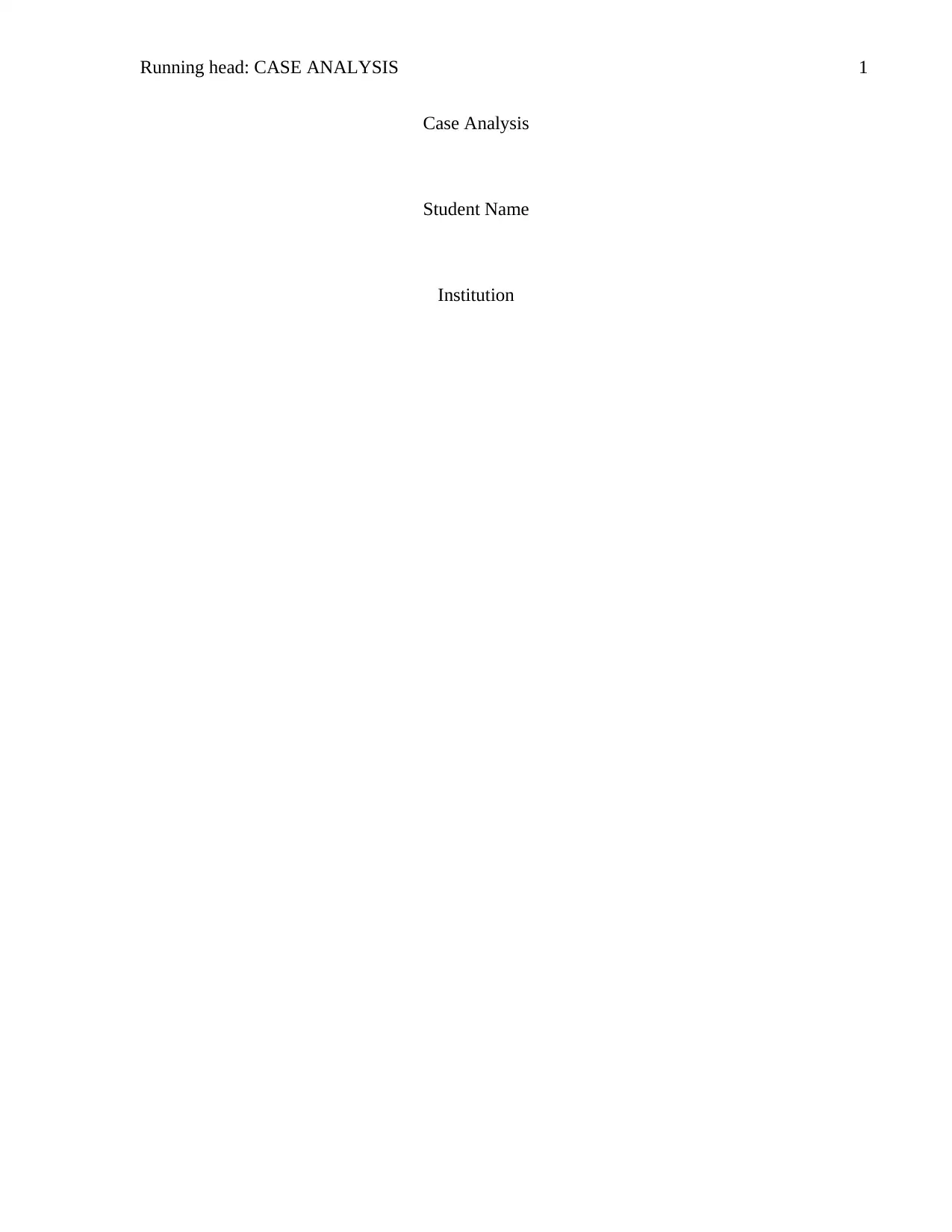
Running head: CASE ANALYSIS 1
Case Analysis
Student Name
Institution
Case Analysis
Student Name
Institution
Paraphrase This Document
Need a fresh take? Get an instant paraphrase of this document with our AI Paraphraser
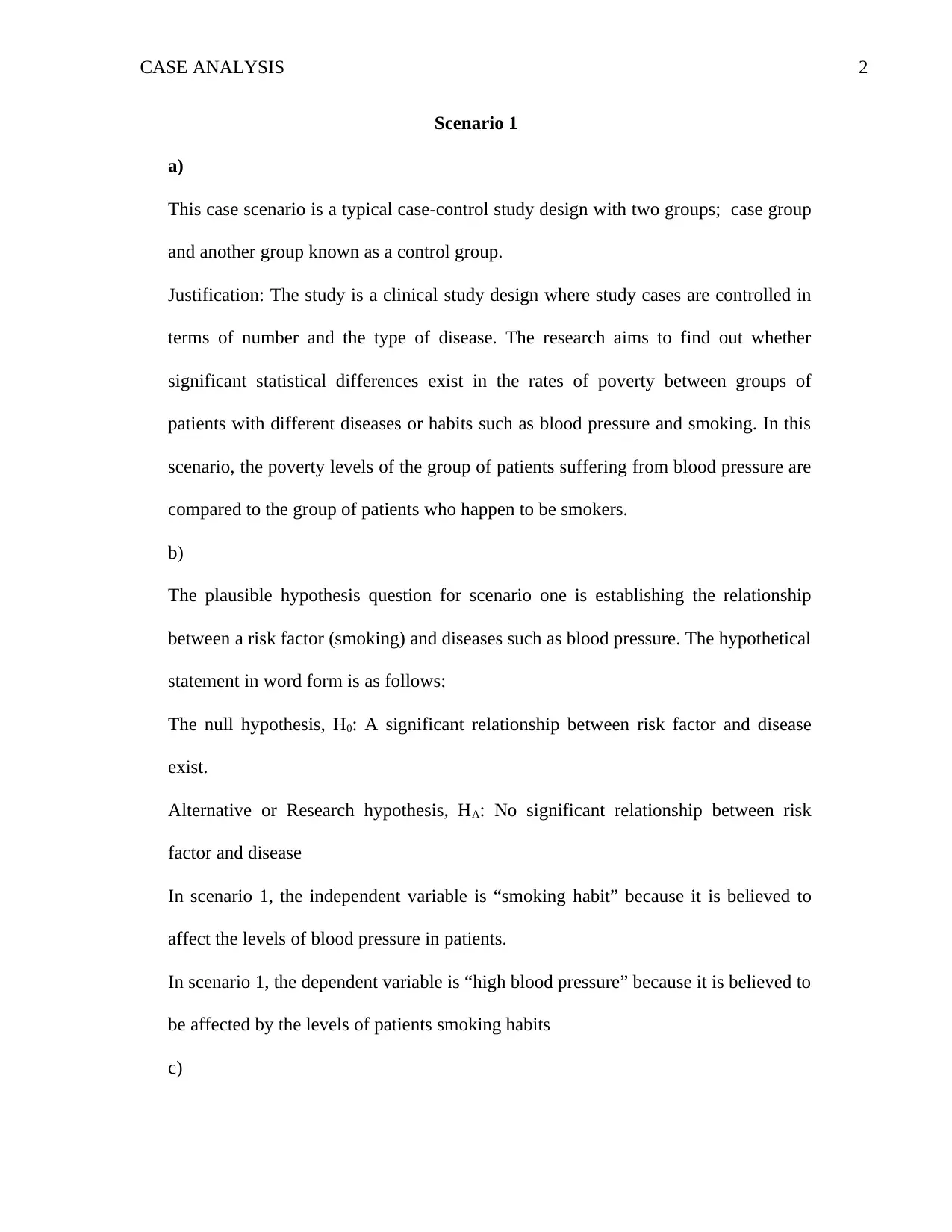
CASE ANALYSIS 2
Scenario 1
a)
This case scenario is a typical case-control study design with two groups; case group
and another group known as a control group.
Justification: The study is a clinical study design where study cases are controlled in
terms of number and the type of disease. The research aims to find out whether
significant statistical differences exist in the rates of poverty between groups of
patients with different diseases or habits such as blood pressure and smoking. In this
scenario, the poverty levels of the group of patients suffering from blood pressure are
compared to the group of patients who happen to be smokers.
b)
The plausible hypothesis question for scenario one is establishing the relationship
between a risk factor (smoking) and diseases such as blood pressure. The hypothetical
statement in word form is as follows:
The null hypothesis, H0: A significant relationship between risk factor and disease
exist.
Alternative or Research hypothesis, HA: No significant relationship between risk
factor and disease
In scenario 1, the independent variable is “smoking habit” because it is believed to
affect the levels of blood pressure in patients.
In scenario 1, the dependent variable is “high blood pressure” because it is believed to
be affected by the levels of patients smoking habits
c)
Scenario 1
a)
This case scenario is a typical case-control study design with two groups; case group
and another group known as a control group.
Justification: The study is a clinical study design where study cases are controlled in
terms of number and the type of disease. The research aims to find out whether
significant statistical differences exist in the rates of poverty between groups of
patients with different diseases or habits such as blood pressure and smoking. In this
scenario, the poverty levels of the group of patients suffering from blood pressure are
compared to the group of patients who happen to be smokers.
b)
The plausible hypothesis question for scenario one is establishing the relationship
between a risk factor (smoking) and diseases such as blood pressure. The hypothetical
statement in word form is as follows:
The null hypothesis, H0: A significant relationship between risk factor and disease
exist.
Alternative or Research hypothesis, HA: No significant relationship between risk
factor and disease
In scenario 1, the independent variable is “smoking habit” because it is believed to
affect the levels of blood pressure in patients.
In scenario 1, the dependent variable is “high blood pressure” because it is believed to
be affected by the levels of patients smoking habits
c)
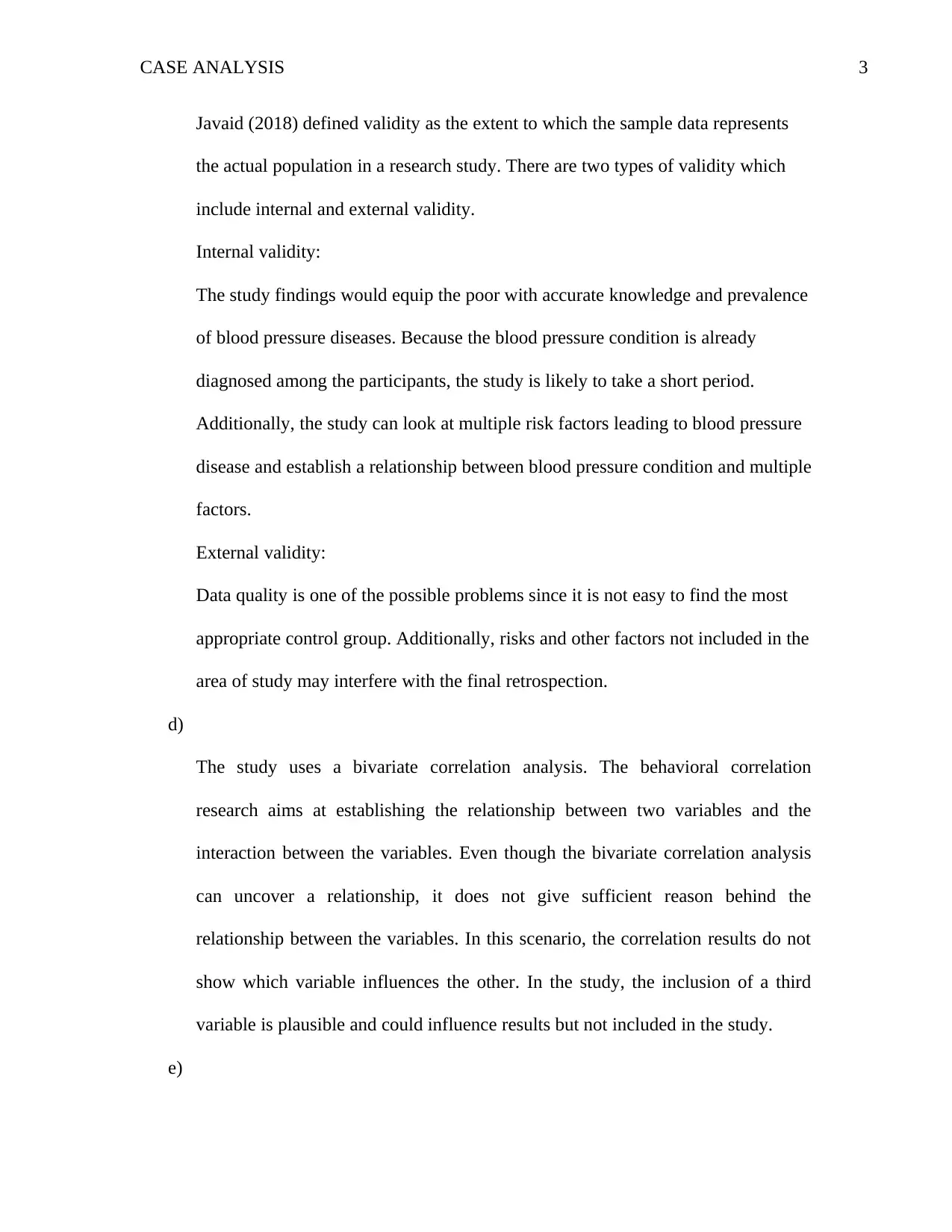
CASE ANALYSIS 3
Javaid (2018) defined validity as the extent to which the sample data represents
the actual population in a research study. There are two types of validity which
include internal and external validity.
Internal validity:
The study findings would equip the poor with accurate knowledge and prevalence
of blood pressure diseases. Because the blood pressure condition is already
diagnosed among the participants, the study is likely to take a short period.
Additionally, the study can look at multiple risk factors leading to blood pressure
disease and establish a relationship between blood pressure condition and multiple
factors.
External validity:
Data quality is one of the possible problems since it is not easy to find the most
appropriate control group. Additionally, risks and other factors not included in the
area of study may interfere with the final retrospection.
d)
The study uses a bivariate correlation analysis. The behavioral correlation
research aims at establishing the relationship between two variables and the
interaction between the variables. Even though the bivariate correlation analysis
can uncover a relationship, it does not give sufficient reason behind the
relationship between the variables. In this scenario, the correlation results do not
show which variable influences the other. In the study, the inclusion of a third
variable is plausible and could influence results but not included in the study.
e)
Javaid (2018) defined validity as the extent to which the sample data represents
the actual population in a research study. There are two types of validity which
include internal and external validity.
Internal validity:
The study findings would equip the poor with accurate knowledge and prevalence
of blood pressure diseases. Because the blood pressure condition is already
diagnosed among the participants, the study is likely to take a short period.
Additionally, the study can look at multiple risk factors leading to blood pressure
disease and establish a relationship between blood pressure condition and multiple
factors.
External validity:
Data quality is one of the possible problems since it is not easy to find the most
appropriate control group. Additionally, risks and other factors not included in the
area of study may interfere with the final retrospection.
d)
The study uses a bivariate correlation analysis. The behavioral correlation
research aims at establishing the relationship between two variables and the
interaction between the variables. Even though the bivariate correlation analysis
can uncover a relationship, it does not give sufficient reason behind the
relationship between the variables. In this scenario, the correlation results do not
show which variable influences the other. In the study, the inclusion of a third
variable is plausible and could influence results but not included in the study.
e)
⊘ This is a preview!⊘
Do you want full access?
Subscribe today to unlock all pages.

Trusted by 1+ million students worldwide
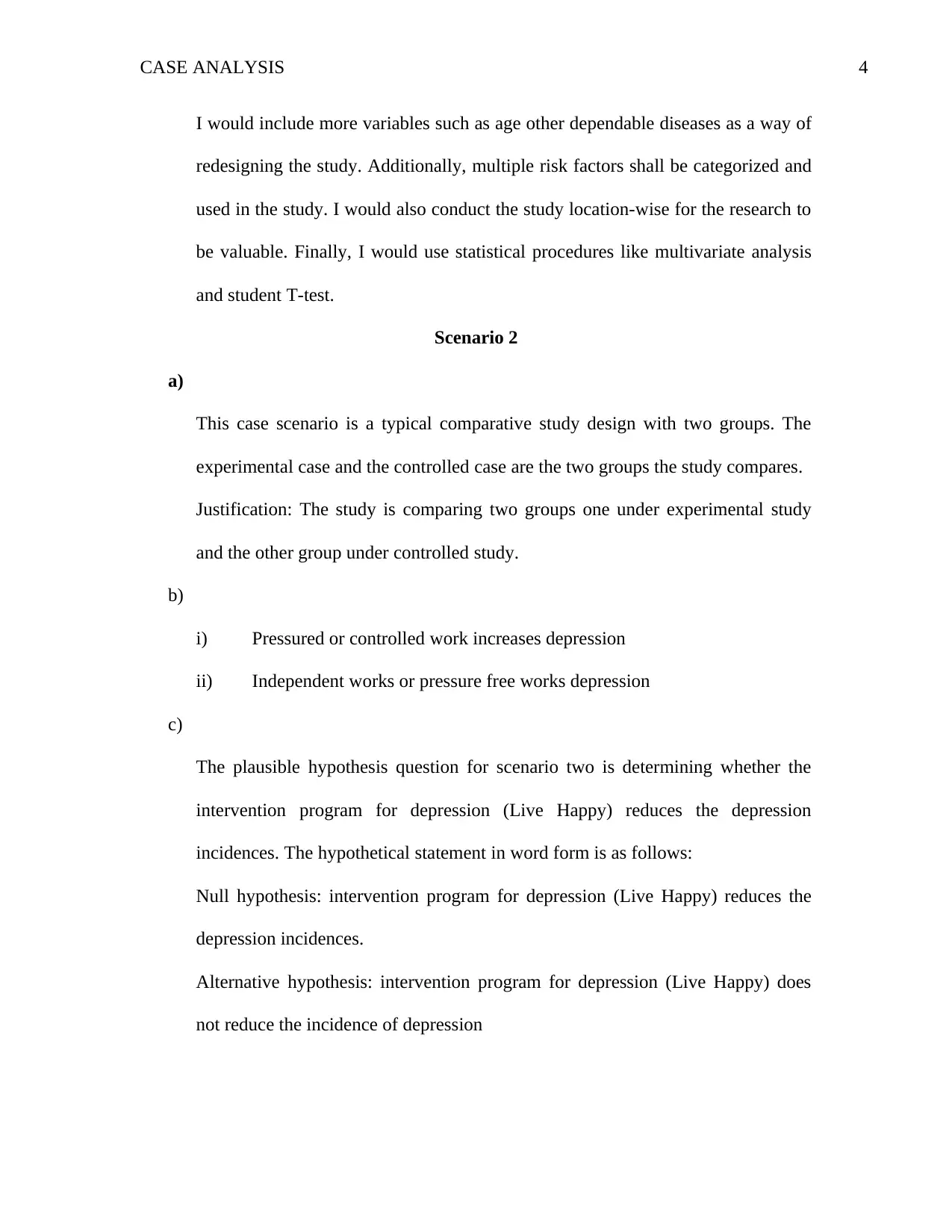
CASE ANALYSIS 4
I would include more variables such as age other dependable diseases as a way of
redesigning the study. Additionally, multiple risk factors shall be categorized and
used in the study. I would also conduct the study location-wise for the research to
be valuable. Finally, I would use statistical procedures like multivariate analysis
and student T-test.
Scenario 2
a)
This case scenario is a typical comparative study design with two groups. The
experimental case and the controlled case are the two groups the study compares.
Justification: The study is comparing two groups one under experimental study
and the other group under controlled study.
b)
i) Pressured or controlled work increases depression
ii) Independent works or pressure free works depression
c)
The plausible hypothesis question for scenario two is determining whether the
intervention program for depression (Live Happy) reduces the depression
incidences. The hypothetical statement in word form is as follows:
Null hypothesis: intervention program for depression (Live Happy) reduces the
depression incidences.
Alternative hypothesis: intervention program for depression (Live Happy) does
not reduce the incidence of depression
I would include more variables such as age other dependable diseases as a way of
redesigning the study. Additionally, multiple risk factors shall be categorized and
used in the study. I would also conduct the study location-wise for the research to
be valuable. Finally, I would use statistical procedures like multivariate analysis
and student T-test.
Scenario 2
a)
This case scenario is a typical comparative study design with two groups. The
experimental case and the controlled case are the two groups the study compares.
Justification: The study is comparing two groups one under experimental study
and the other group under controlled study.
b)
i) Pressured or controlled work increases depression
ii) Independent works or pressure free works depression
c)
The plausible hypothesis question for scenario two is determining whether the
intervention program for depression (Live Happy) reduces the depression
incidences. The hypothetical statement in word form is as follows:
Null hypothesis: intervention program for depression (Live Happy) reduces the
depression incidences.
Alternative hypothesis: intervention program for depression (Live Happy) does
not reduce the incidence of depression
Paraphrase This Document
Need a fresh take? Get an instant paraphrase of this document with our AI Paraphraser
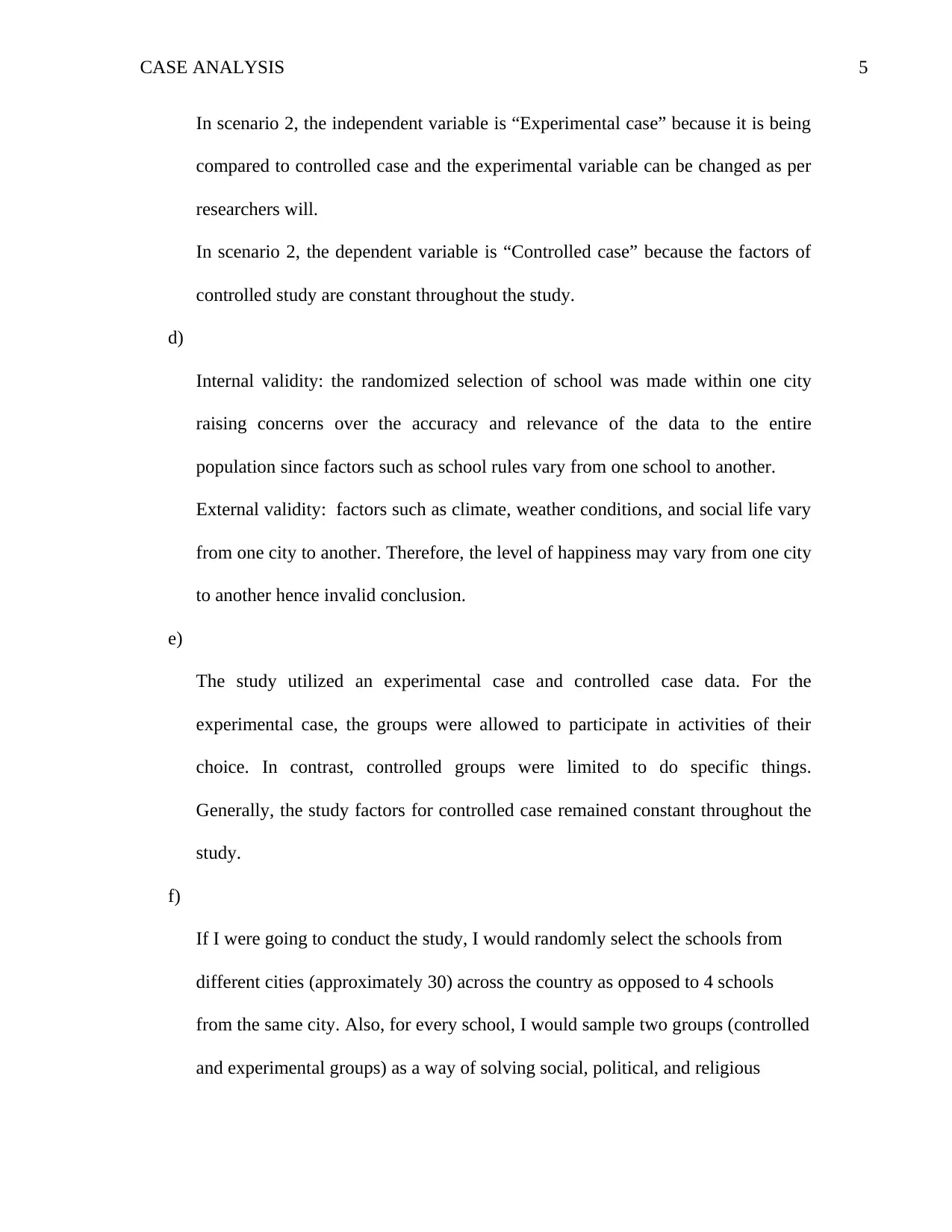
CASE ANALYSIS 5
In scenario 2, the independent variable is “Experimental case” because it is being
compared to controlled case and the experimental variable can be changed as per
researchers will.
In scenario 2, the dependent variable is “Controlled case” because the factors of
controlled study are constant throughout the study.
d)
Internal validity: the randomized selection of school was made within one city
raising concerns over the accuracy and relevance of the data to the entire
population since factors such as school rules vary from one school to another.
External validity: factors such as climate, weather conditions, and social life vary
from one city to another. Therefore, the level of happiness may vary from one city
to another hence invalid conclusion.
e)
The study utilized an experimental case and controlled case data. For the
experimental case, the groups were allowed to participate in activities of their
choice. In contrast, controlled groups were limited to do specific things.
Generally, the study factors for controlled case remained constant throughout the
study.
f)
If I were going to conduct the study, I would randomly select the schools from
different cities (approximately 30) across the country as opposed to 4 schools
from the same city. Also, for every school, I would sample two groups (controlled
and experimental groups) as a way of solving social, political, and religious
In scenario 2, the independent variable is “Experimental case” because it is being
compared to controlled case and the experimental variable can be changed as per
researchers will.
In scenario 2, the dependent variable is “Controlled case” because the factors of
controlled study are constant throughout the study.
d)
Internal validity: the randomized selection of school was made within one city
raising concerns over the accuracy and relevance of the data to the entire
population since factors such as school rules vary from one school to another.
External validity: factors such as climate, weather conditions, and social life vary
from one city to another. Therefore, the level of happiness may vary from one city
to another hence invalid conclusion.
e)
The study utilized an experimental case and controlled case data. For the
experimental case, the groups were allowed to participate in activities of their
choice. In contrast, controlled groups were limited to do specific things.
Generally, the study factors for controlled case remained constant throughout the
study.
f)
If I were going to conduct the study, I would randomly select the schools from
different cities (approximately 30) across the country as opposed to 4 schools
from the same city. Also, for every school, I would sample two groups (controlled
and experimental groups) as a way of solving social, political, and religious
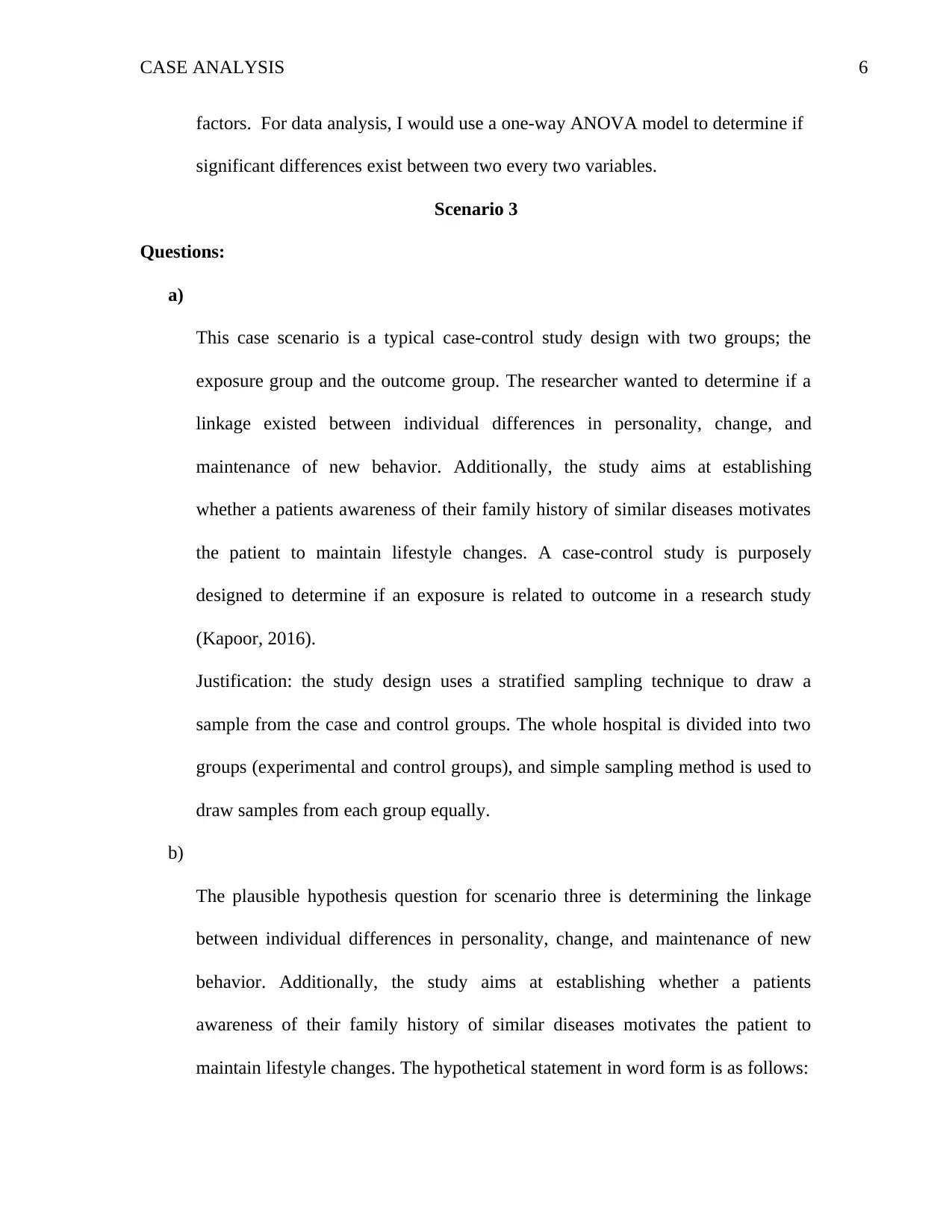
CASE ANALYSIS 6
factors. For data analysis, I would use a one-way ANOVA model to determine if
significant differences exist between two every two variables.
Scenario 3
Questions:
a)
This case scenario is a typical case-control study design with two groups; the
exposure group and the outcome group. The researcher wanted to determine if a
linkage existed between individual differences in personality, change, and
maintenance of new behavior. Additionally, the study aims at establishing
whether a patients awareness of their family history of similar diseases motivates
the patient to maintain lifestyle changes. A case-control study is purposely
designed to determine if an exposure is related to outcome in a research study
(Kapoor, 2016).
Justification: the study design uses a stratified sampling technique to draw a
sample from the case and control groups. The whole hospital is divided into two
groups (experimental and control groups), and simple sampling method is used to
draw samples from each group equally.
b)
The plausible hypothesis question for scenario three is determining the linkage
between individual differences in personality, change, and maintenance of new
behavior. Additionally, the study aims at establishing whether a patients
awareness of their family history of similar diseases motivates the patient to
maintain lifestyle changes. The hypothetical statement in word form is as follows:
factors. For data analysis, I would use a one-way ANOVA model to determine if
significant differences exist between two every two variables.
Scenario 3
Questions:
a)
This case scenario is a typical case-control study design with two groups; the
exposure group and the outcome group. The researcher wanted to determine if a
linkage existed between individual differences in personality, change, and
maintenance of new behavior. Additionally, the study aims at establishing
whether a patients awareness of their family history of similar diseases motivates
the patient to maintain lifestyle changes. A case-control study is purposely
designed to determine if an exposure is related to outcome in a research study
(Kapoor, 2016).
Justification: the study design uses a stratified sampling technique to draw a
sample from the case and control groups. The whole hospital is divided into two
groups (experimental and control groups), and simple sampling method is used to
draw samples from each group equally.
b)
The plausible hypothesis question for scenario three is determining the linkage
between individual differences in personality, change, and maintenance of new
behavior. Additionally, the study aims at establishing whether a patients
awareness of their family history of similar diseases motivates the patient to
maintain lifestyle changes. The hypothetical statement in word form is as follows:
⊘ This is a preview!⊘
Do you want full access?
Subscribe today to unlock all pages.

Trusted by 1+ million students worldwide
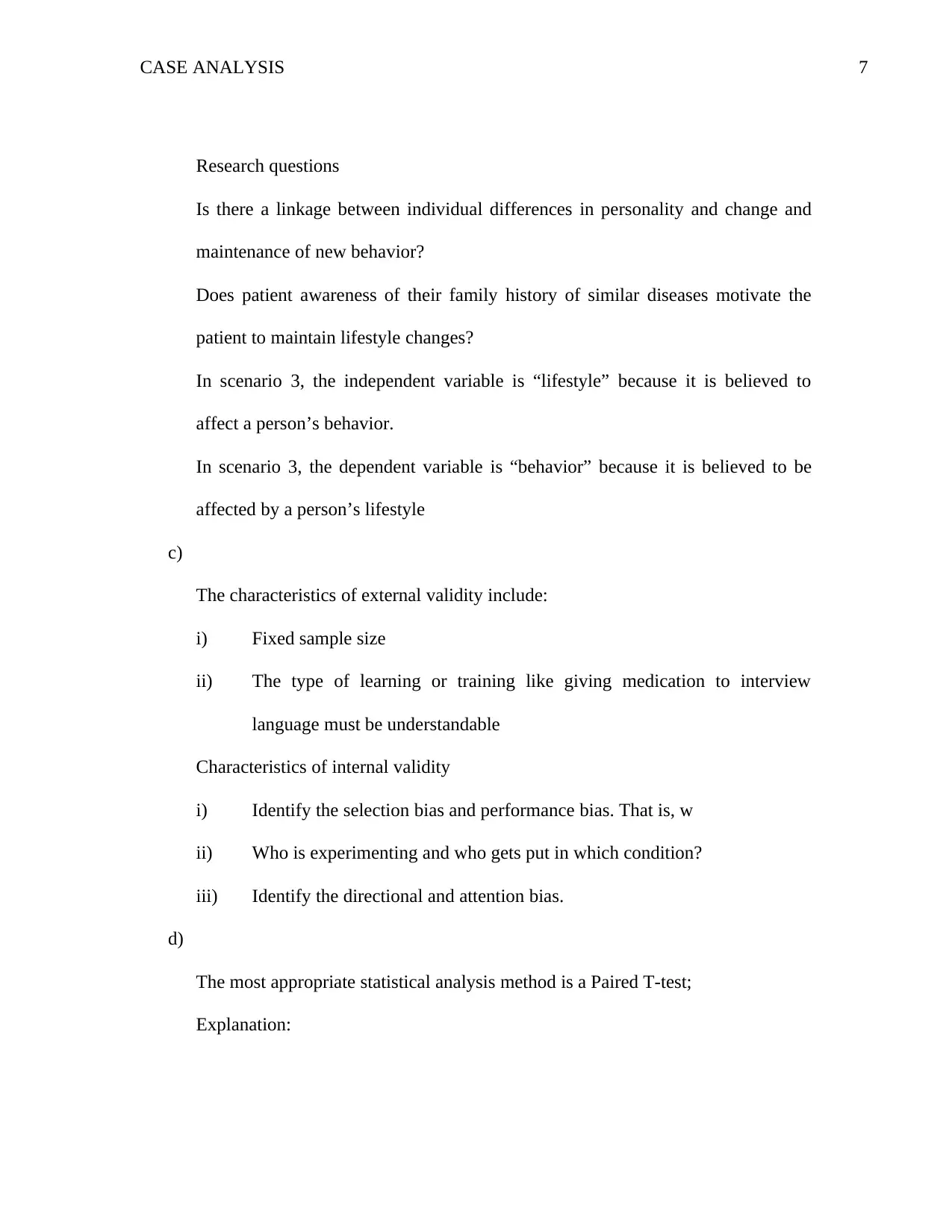
CASE ANALYSIS 7
Research questions
Is there a linkage between individual differences in personality and change and
maintenance of new behavior?
Does patient awareness of their family history of similar diseases motivate the
patient to maintain lifestyle changes?
In scenario 3, the independent variable is “lifestyle” because it is believed to
affect a person’s behavior.
In scenario 3, the dependent variable is “behavior” because it is believed to be
affected by a person’s lifestyle
c)
The characteristics of external validity include:
i) Fixed sample size
ii) The type of learning or training like giving medication to interview
language must be understandable
Characteristics of internal validity
i) Identify the selection bias and performance bias. That is, w
ii) Who is experimenting and who gets put in which condition?
iii) Identify the directional and attention bias.
d)
The most appropriate statistical analysis method is a Paired T-test;
Explanation:
Research questions
Is there a linkage between individual differences in personality and change and
maintenance of new behavior?
Does patient awareness of their family history of similar diseases motivate the
patient to maintain lifestyle changes?
In scenario 3, the independent variable is “lifestyle” because it is believed to
affect a person’s behavior.
In scenario 3, the dependent variable is “behavior” because it is believed to be
affected by a person’s lifestyle
c)
The characteristics of external validity include:
i) Fixed sample size
ii) The type of learning or training like giving medication to interview
language must be understandable
Characteristics of internal validity
i) Identify the selection bias and performance bias. That is, w
ii) Who is experimenting and who gets put in which condition?
iii) Identify the directional and attention bias.
d)
The most appropriate statistical analysis method is a Paired T-test;
Explanation:
Paraphrase This Document
Need a fresh take? Get an instant paraphrase of this document with our AI Paraphraser
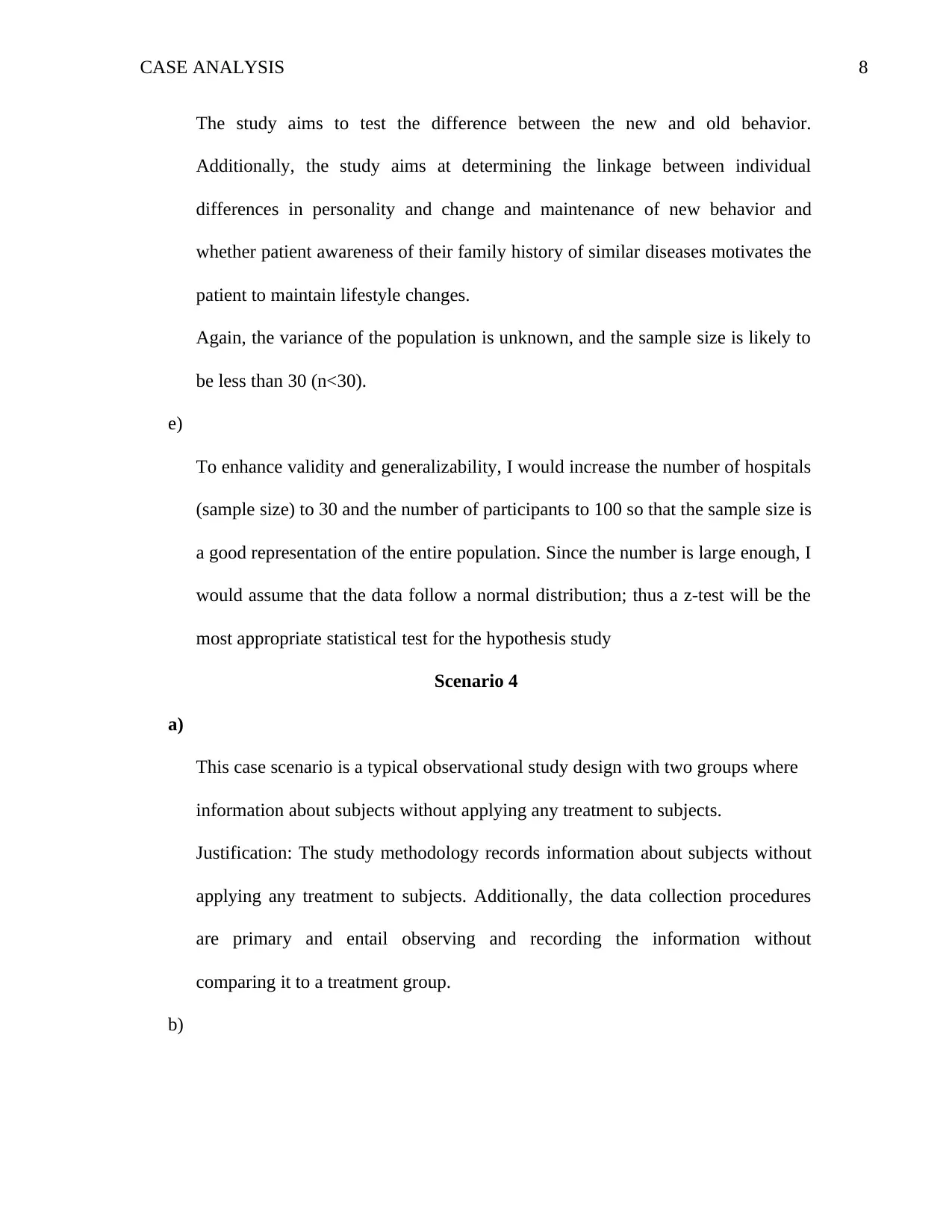
CASE ANALYSIS 8
The study aims to test the difference between the new and old behavior.
Additionally, the study aims at determining the linkage between individual
differences in personality and change and maintenance of new behavior and
whether patient awareness of their family history of similar diseases motivates the
patient to maintain lifestyle changes.
Again, the variance of the population is unknown, and the sample size is likely to
be less than 30 (n<30).
e)
To enhance validity and generalizability, I would increase the number of hospitals
(sample size) to 30 and the number of participants to 100 so that the sample size is
a good representation of the entire population. Since the number is large enough, I
would assume that the data follow a normal distribution; thus a z-test will be the
most appropriate statistical test for the hypothesis study
Scenario 4
a)
This case scenario is a typical observational study design with two groups where
information about subjects without applying any treatment to subjects.
Justification: The study methodology records information about subjects without
applying any treatment to subjects. Additionally, the data collection procedures
are primary and entail observing and recording the information without
comparing it to a treatment group.
b)
The study aims to test the difference between the new and old behavior.
Additionally, the study aims at determining the linkage between individual
differences in personality and change and maintenance of new behavior and
whether patient awareness of their family history of similar diseases motivates the
patient to maintain lifestyle changes.
Again, the variance of the population is unknown, and the sample size is likely to
be less than 30 (n<30).
e)
To enhance validity and generalizability, I would increase the number of hospitals
(sample size) to 30 and the number of participants to 100 so that the sample size is
a good representation of the entire population. Since the number is large enough, I
would assume that the data follow a normal distribution; thus a z-test will be the
most appropriate statistical test for the hypothesis study
Scenario 4
a)
This case scenario is a typical observational study design with two groups where
information about subjects without applying any treatment to subjects.
Justification: The study methodology records information about subjects without
applying any treatment to subjects. Additionally, the data collection procedures
are primary and entail observing and recording the information without
comparing it to a treatment group.
b)
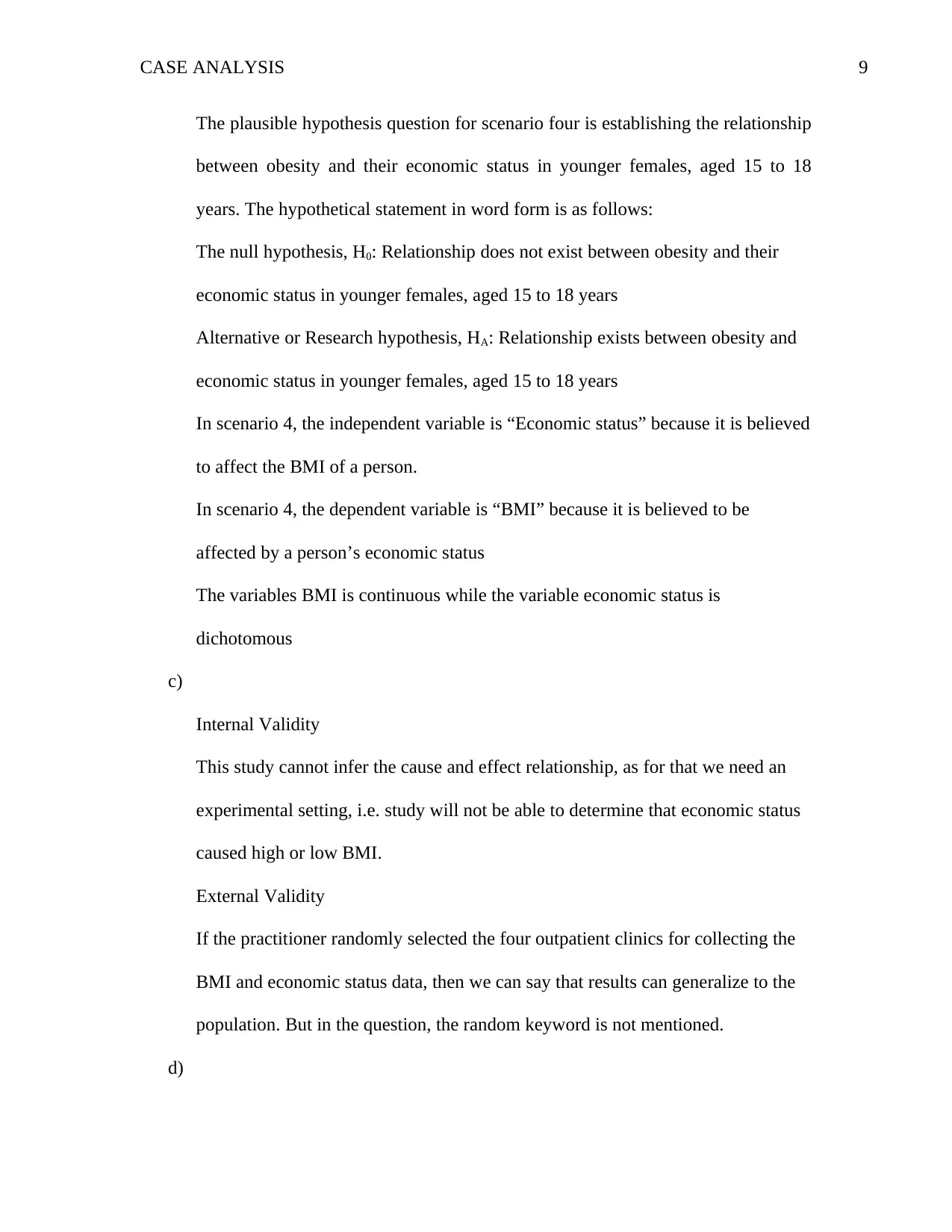
CASE ANALYSIS 9
The plausible hypothesis question for scenario four is establishing the relationship
between obesity and their economic status in younger females, aged 15 to 18
years. The hypothetical statement in word form is as follows:
The null hypothesis, H0: Relationship does not exist between obesity and their
economic status in younger females, aged 15 to 18 years
Alternative or Research hypothesis, HA: Relationship exists between obesity and
economic status in younger females, aged 15 to 18 years
In scenario 4, the independent variable is “Economic status” because it is believed
to affect the BMI of a person.
In scenario 4, the dependent variable is “BMI” because it is believed to be
affected by a person’s economic status
The variables BMI is continuous while the variable economic status is
dichotomous
c)
Internal Validity
This study cannot infer the cause and effect relationship, as for that we need an
experimental setting, i.e. study will not be able to determine that economic status
caused high or low BMI.
External Validity
If the practitioner randomly selected the four outpatient clinics for collecting the
BMI and economic status data, then we can say that results can generalize to the
population. But in the question, the random keyword is not mentioned.
d)
The plausible hypothesis question for scenario four is establishing the relationship
between obesity and their economic status in younger females, aged 15 to 18
years. The hypothetical statement in word form is as follows:
The null hypothesis, H0: Relationship does not exist between obesity and their
economic status in younger females, aged 15 to 18 years
Alternative or Research hypothesis, HA: Relationship exists between obesity and
economic status in younger females, aged 15 to 18 years
In scenario 4, the independent variable is “Economic status” because it is believed
to affect the BMI of a person.
In scenario 4, the dependent variable is “BMI” because it is believed to be
affected by a person’s economic status
The variables BMI is continuous while the variable economic status is
dichotomous
c)
Internal Validity
This study cannot infer the cause and effect relationship, as for that we need an
experimental setting, i.e. study will not be able to determine that economic status
caused high or low BMI.
External Validity
If the practitioner randomly selected the four outpatient clinics for collecting the
BMI and economic status data, then we can say that results can generalize to the
population. But in the question, the random keyword is not mentioned.
d)
⊘ This is a preview!⊘
Do you want full access?
Subscribe today to unlock all pages.

Trusted by 1+ million students worldwide
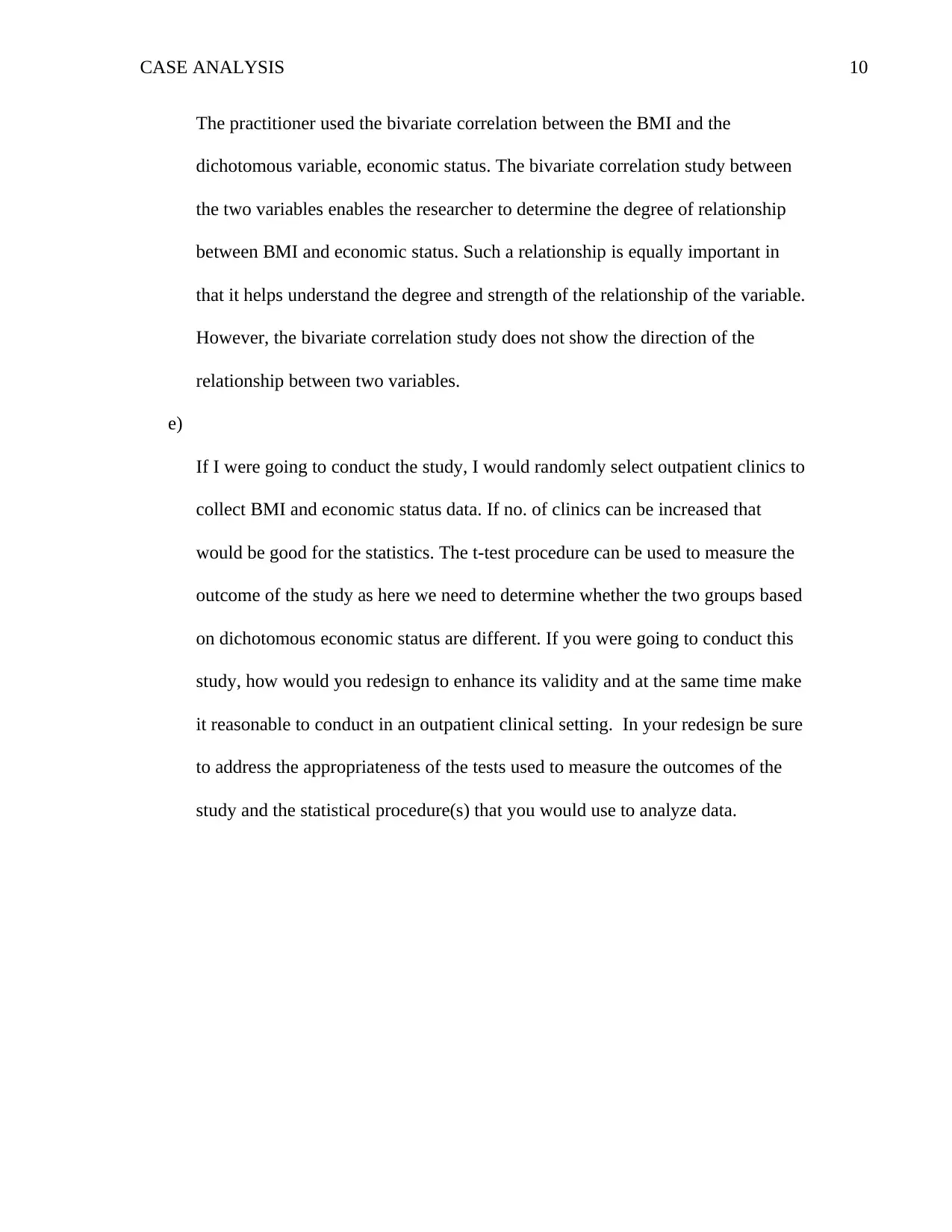
CASE ANALYSIS 10
The practitioner used the bivariate correlation between the BMI and the
dichotomous variable, economic status. The bivariate correlation study between
the two variables enables the researcher to determine the degree of relationship
between BMI and economic status. Such a relationship is equally important in
that it helps understand the degree and strength of the relationship of the variable.
However, the bivariate correlation study does not show the direction of the
relationship between two variables.
e)
If I were going to conduct the study, I would randomly select outpatient clinics to
collect BMI and economic status data. If no. of clinics can be increased that
would be good for the statistics. The t-test procedure can be used to measure the
outcome of the study as here we need to determine whether the two groups based
on dichotomous economic status are different. If you were going to conduct this
study, how would you redesign to enhance its validity and at the same time make
it reasonable to conduct in an outpatient clinical setting. In your redesign be sure
to address the appropriateness of the tests used to measure the outcomes of the
study and the statistical procedure(s) that you would use to analyze data.
The practitioner used the bivariate correlation between the BMI and the
dichotomous variable, economic status. The bivariate correlation study between
the two variables enables the researcher to determine the degree of relationship
between BMI and economic status. Such a relationship is equally important in
that it helps understand the degree and strength of the relationship of the variable.
However, the bivariate correlation study does not show the direction of the
relationship between two variables.
e)
If I were going to conduct the study, I would randomly select outpatient clinics to
collect BMI and economic status data. If no. of clinics can be increased that
would be good for the statistics. The t-test procedure can be used to measure the
outcome of the study as here we need to determine whether the two groups based
on dichotomous economic status are different. If you were going to conduct this
study, how would you redesign to enhance its validity and at the same time make
it reasonable to conduct in an outpatient clinical setting. In your redesign be sure
to address the appropriateness of the tests used to measure the outcomes of the
study and the statistical procedure(s) that you would use to analyze data.
Paraphrase This Document
Need a fresh take? Get an instant paraphrase of this document with our AI Paraphraser
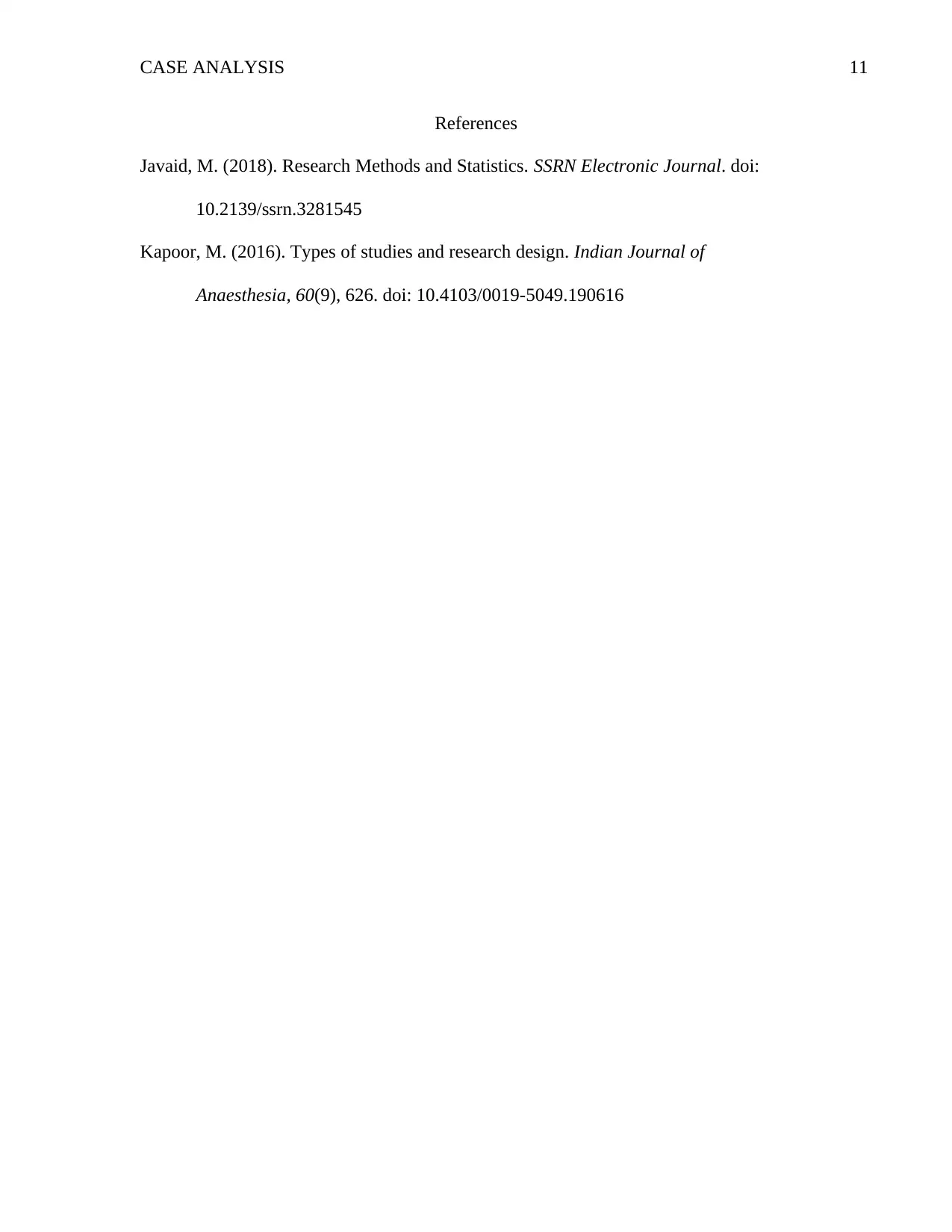
CASE ANALYSIS 11
References
Javaid, M. (2018). Research Methods and Statistics. SSRN Electronic Journal. doi:
10.2139/ssrn.3281545
Kapoor, M. (2016). Types of studies and research design. Indian Journal of
Anaesthesia, 60(9), 626. doi: 10.4103/0019-5049.190616
References
Javaid, M. (2018). Research Methods and Statistics. SSRN Electronic Journal. doi:
10.2139/ssrn.3281545
Kapoor, M. (2016). Types of studies and research design. Indian Journal of
Anaesthesia, 60(9), 626. doi: 10.4103/0019-5049.190616
1 out of 11
Related Documents
Your All-in-One AI-Powered Toolkit for Academic Success.
+13062052269
info@desklib.com
Available 24*7 on WhatsApp / Email
![[object Object]](/_next/static/media/star-bottom.7253800d.svg)
Unlock your academic potential
Copyright © 2020–2025 A2Z Services. All Rights Reserved. Developed and managed by ZUCOL.





